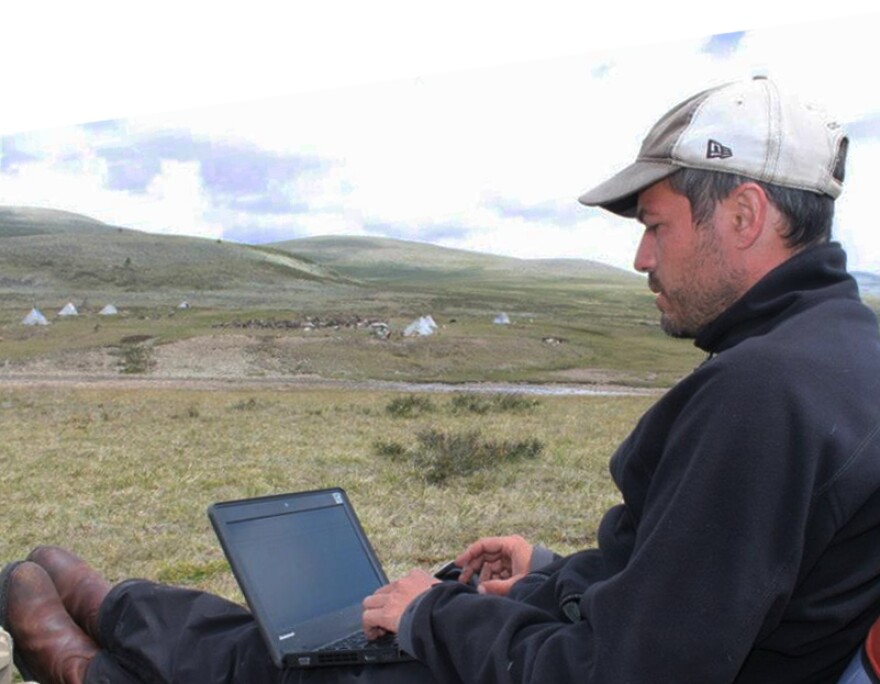A Wyoming Archaeologist’s work in Mongolia is shedding new light on the prehistoric people of the Rocky
Mountains. Wyoming Public Radio’s Sara Hossaini reports.
SARA HOSSAINI: University of Wyoming archaeologist Todd Surovell spends a lot of time thinking about how humans organize the space around us. In particular, our junk.
TODD SUROVELL: I don’t think archaeologists commonly portray themselves as studiers of trash, but that’s what we do. Ninety-nine percent of what we find in the archaeological record is refuse.
HOSSAINI: That’s important because early hominids left a rather homogenous scattering of bones, ash, and tools. While the deliberate use of space—where you sleep, where you toss your leftover bones—is an example of modern human behavior most scientists believe came about at least 50 thousand years ago. In other words, how we choose where we do things is a big part of what makes us human.
Surovell studies nomads who lived here. The problem for Surovell is that most nomads, then and now, leave very little on the ground. When you do find a prehistoric hunter-gatherer campground, the likes of which are sprinkled across Wyoming and Colorado, you are often left with more questions than answers.
Surovell was working on one such dig, the twelve thousand five hundred year-old Folsom Site in Colorado, when he found himself mulling simple things—Why are there more artifacts clustered on one side of the tipis than the other? Did people live here in the winter?
SUROVELL: Amazingly, something as simple as that has never been studied by anthropologists in any meaningful way.
HOSSAINI: And then it occurred to him. What if there were modern people living similar lifestyles who could offer some clues?
SUROVELL: After looking at endless spatial patterns that we discovered in the site, I felt like we really didn’t have very good means for understanding them. So I wanted to view this in the real world, in a nomadic setting where you still had nomadic peoples today.
HOSSAINI: Turns out there aren’t too many places in the world left to choose from, especially those boasting temperate climates like the Rocky Mountains. Eventually, Surovell settled on the Dhokha, nomadic reindeer herders who live in tipis along the mountain-ringed steppes of northern Mongolia, which are reminiscent of his study area back home.
Surovell had come up with an innovative idea—he wanted to see if he could shift the focus from mapping material remains, to mapping actual people by taking pictures of a campsite from a variety of angles, every two minutes, for a month.
SUROVELL: What I was trying to do first was to develop a completely new method for doing spatial ethnography, which is one mapping people, and two doing time-lapse photography to do it. So my primary goal was to establish, is this possible?
HOSSAINI: This summer, Surovell and a partner left to find out…after ten bags, three airports, a nine hour drive and 20 mile horse-pack into the mountains, he says the Dhokha people welcomed them with a question…
SUROVELL: “You know they look at you and they say, ‘What do you need all that stuff for?’” (laughs)
HOSSAINI: Soon, Surovell was asking each tipi’s inhabitants permission to hoist a camera on a 30-foot pole. He admits their reaction to the proposed neighborhood watch was focused on an issue of logistics…“where are we going to go to the bathroom now?” But no one refused. And soon, Surovell’s team was hosting nightly screenings of the day’s footage for the entertainment of delighted residents. And they gave back in kind. (Song)
HOSSAINI: Back at home in Laramie, Surovell has gathered four research students into his office to listen to the sounds of the modern-Mongolian nomads whose images they have spent countless hours crunching into daily maps with hundreds of little red dots, which represent individual movements.
KIMBERLY SANCHEZ: 5,300 and some photos, it’s a lot of photos.
HOSSAINI: That’s student Kimberly Sanchez. The work is tedious, but student Travis Carlton says that studying living people is illuminating.
TRAVIS CARLTON: As archaeologists, it’s kind of a stones and bones deal. You don’t get to see it in action.
HOSSAINI: Already, the team thinks its time-lapse footage suggests possible overlap between modern and prehistoric behavior. The Dhokha also prefer to hang out on one side of the tipi, it’s called the woman’s side, where the kitchen is located. Surovell hypothesizes.
SUROVELL: People like to hang out in the kitchen. It’s true in my house today, probably in yours as well.
HOSSAINI: But even more striking, Surovell says he has discovered a perfect correlation between the temperature outside and the distance that Dhokha people sit from a campfire. Something he believes could revolutionize the ability of archaeologists to determine the season in which a site was used.
SUROVELL: Now we’ve excavated hundreds of hearths, maybe thousands of hearths, in the arch record with stone tools around them. And there’s the potential that that really simple and obvious finding will eventually lead to a clear way to determine what season of year people were sitting around those fireplaces. So that, that’s exciting to me.
HOSSAINI: Now that he’s sure it’s possible, Surovell hopes to raise enough money to return Mongolia during different seasons and eventually apply his research to sites in the Rocky Mountain region. For Wyoming Public Radio News, I’m Sara Hossaini.






